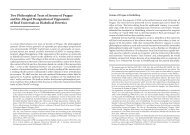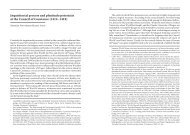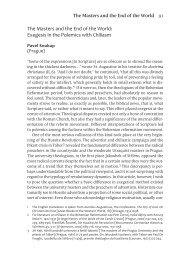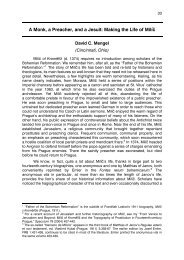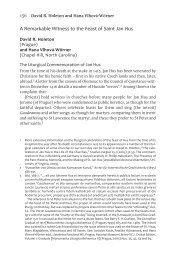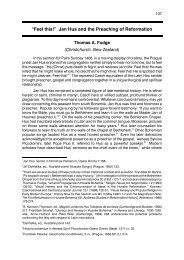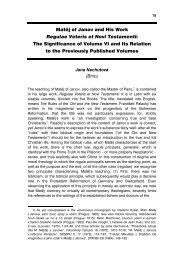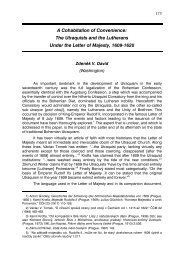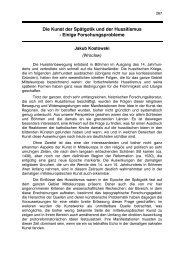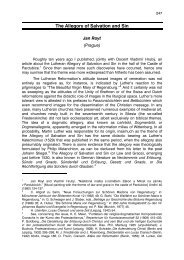Repertory of Proper Tropes - Bohemian Reformation and Religious ...
Repertory of Proper Tropes - Bohemian Reformation and Religious ...
Repertory of Proper Tropes - Bohemian Reformation and Religious ...
Create successful ePaper yourself
Turn your PDF publications into a flip-book with our unique Google optimized e-Paper software.
<strong>Bohemian</strong> Utraquists’ <strong>Repertory</strong> <strong>of</strong> <strong>Proper</strong> <strong>Tropes</strong>*<br />
Hana Vlhová-Wörner<br />
(Berlin <strong>and</strong> Prague)<br />
313<br />
The Latin liturgical repertory from the Utraquist milieu is characterized by<br />
a number <strong>of</strong> remarkable traits, which deserve attention from the viewpoint <strong>of</strong><br />
liturgical musical development not only in Bohemia, but also within the entire<br />
European context. It is true that the song repertory <strong>of</strong> Utraquist choral brotherhoods<br />
[literati] was oriented in considerable part toward polyphonic music, partially<br />
adapted from an earlier tradition, partially created from contemporary domestic <strong>and</strong><br />
European production. Nevertheless, the fundamental component <strong>of</strong> liturgical music,<br />
as it was reflected in the Utraquist Latin graduals <strong>and</strong> kancionáls, 1 still consisted <strong>of</strong><br />
Latin monody until the sixteenth century. New concerns in the area <strong>of</strong> theology or in<br />
everyday ecclesiastical life led to necessary modification. Such were the introduction<br />
<strong>of</strong> new holy days into the liturgical calendar, that <strong>of</strong> Jan Hus above all, as well as the<br />
special emphasis on certain feasts, such as Corpus Christi. These led to the<br />
composition <strong>of</strong> new choral chants, or to the adaptation <strong>of</strong> older musical repertory<br />
dating from before the <strong>Bohemian</strong> <strong>Reformation</strong>. The core <strong>of</strong> the monodic choral<br />
repertory for the main feasts <strong>of</strong> the liturgical year, however, remained unchanged,<br />
<strong>and</strong> passed on into the Utraquist liturgy in the form in which it had been common in<br />
the diocese <strong>of</strong> Prague before the <strong>Bohemian</strong> <strong>Reformation</strong>. The continuation <strong>of</strong> the<br />
older tradition is manifest not only in the prevalent coincidence <strong>of</strong> the musical<br />
repertory for the main feasts <strong>of</strong> the liturgical year, but also in the choice <strong>of</strong> identical<br />
ways in which the celebratory character <strong>of</strong> a given holy day could be highlighted.<br />
This reverent stance <strong>of</strong> the Utraquists to the older tradition also assured an extreme<br />
longevity to the tropes, which retained their secure place in the liturgy <strong>of</strong> the mass<br />
well into the sixteenth century, not only through the preservation <strong>of</strong> the older<br />
repertory, but also through the active composition <strong>of</strong> additional repertory.<br />
The introduction <strong>of</strong> tropes in the mass chants was adopted by the Utraquists<br />
from the older Pre-<strong>Reformation</strong> practice as a means for the refreshment or<br />
ornamentation <strong>of</strong> the liturgical repertory. In part, the troped chants passed on into<br />
the Utraquist repertory as already fully established components <strong>of</strong> the chants <strong>of</strong> the<br />
<strong>Proper</strong> <strong>and</strong> Ordinary <strong>of</strong> the Mass for certain feasts <strong>of</strong> the liturgical year. For instance,<br />
we could not find many manuscripts <strong>of</strong> either sub una provenance (whether Pre- or<br />
* This article originated in connection with the critical edition <strong>of</strong> mass tropes from eleventh to<br />
sixteenth-century <strong>Bohemian</strong> sources, Repertorium Troporum Bohemiae Medii Aevi [RTB], to be<br />
published by Editio-Bärenreiter in Prague, <strong>and</strong>, above all, in preparation for the first volume, Tropi<br />
Proprii Missae (Prague, 2004). My presentation here is based on the data in this edition that concern,<br />
for instance, the availability <strong>of</strong> individual tropes in <strong>Bohemian</strong> manuscripts <strong>and</strong> in the European<br />
tradition. For this reason, I do not ordinarily cite duplicate transcriptions <strong>of</strong> texts or melodies, which<br />
I mention in this article.<br />
1 The literature vacillates in the denotation <strong>of</strong> Utraquist manuscripts containing noted masses. For<br />
instance, one speaks <strong>of</strong> the Franus Kancionál <strong>and</strong> <strong>of</strong> the Gradual <strong>of</strong> Martin Bachelor <strong>of</strong> Vyskytná,<br />
although in reality both are graduals with an appended section <strong>of</strong> religious songs [cantiones], some<br />
also polyphonic.
314<br />
Post-<strong>Reformation</strong>), or <strong>of</strong> Utraquist origin, which would lack among the Marian mass<br />
chants the <strong>of</strong>fertory Recordare, virgo mater with the trope Ab hac familia (RTB I, OffTr<br />
2). Similarly, virtually all the manuscripts (<strong>of</strong> either provenance) after 1400 contain<br />
among the chants for the mass <strong>of</strong> Corpus Christi the <strong>of</strong>fertory Sacerdotes incensum<br />
with the trope Ave, salus Christianorum (RTB I, OffTr 4). 2 Similar cases can be cited<br />
from the domain <strong>of</strong> the chants for the Ordinary. For instance, the collection <strong>of</strong> tropes<br />
for the Sanctus in most manuscripts <strong>of</strong> <strong>Bohemian</strong> origin is introduced by the chant<br />
Deus pater, iudex iusticie, 3 regardless <strong>of</strong> their provenance or date. On the other<br />
h<strong>and</strong>, the Utraquists’ choral repertory underwent all the musical <strong>and</strong> textual changes<br />
which affected the monodic liturgical chant in the late Middle Ages. Similarly, it<br />
adopted the new forms, which developed in this era. As in the sub una repertory <strong>of</strong><br />
both the Pre- <strong>and</strong> Post-<strong>Reformation</strong> period, so also in the Utraquist repertory the<br />
alleluia chants became widespread with their verses interlarded with strophic<br />
songs. 4 This technique represented the extreme form <strong>of</strong> interpolation (tropes) <strong>of</strong> the<br />
liturgical chant, <strong>and</strong> was also transferred to other chants <strong>of</strong> the mass. It can be<br />
documented also from the choral books <strong>of</strong> Utraquist origin, but such chants are not<br />
treated in this article. However, in the Utraquist milieu at the end <strong>of</strong> the fifteenth <strong>and</strong><br />
the beginning <strong>of</strong> the sixteenth centuries there was still equally current the older<br />
technique <strong>of</strong> the textation <strong>of</strong> melismatic chants, which in the mass were represented,<br />
above all, by graduals <strong>and</strong> alleluias.<br />
The survey <strong>of</strong> the chants <strong>of</strong> mass propers with tropes from selected Utraquist<br />
graduals <strong>and</strong> kancionáls in Table 1 indicates an important fact: the Utraquist<br />
repertory did not uphold a uniform canon <strong>of</strong> chants with tropes, which would be<br />
common to all Utraquist churches. Neither is there uniformity in relation to the earlier<br />
tradition sub una (see column K): the prologue Gregorius presul meritis to the introit<br />
for the First Sunday in Advent Ad te levati, which is characteristic for Prague liturgy<br />
before the <strong>Bohemian</strong> <strong>Reformation</strong>, analogously introduces in certain Utraquist<br />
graduals (in TAB. 1 represented by the Litoměřice Gradual from 1517 5 ) the set <strong>of</strong><br />
mass chants for the liturgical year in certain Utraquist graduals. Nevertheless, they<br />
do not appear in such notable mass books as the Kutná Hora Gradual from the<br />
1490s (Vienna, Österreichische Nationalbibliothek Mus. Hs. [Wi] 15501), 6 the Franus<br />
Kancionál from the choir <strong>of</strong> the church <strong>of</strong> the Holy Spirit in Hradec Králové from<br />
2 The trope Ave salus Christianorum – in the Czech version Budiž pozdraveno Tělo Kristovo – also<br />
appears as a part <strong>of</strong> the mass proper for the feast day <strong>of</strong> Corpus Christi in the Jistebnice Hymnal; see<br />
Jaroslav Kolár, Anežka Widmanová, <strong>and</strong> Hana Vlhová Wörner, Jistebnický kancionál: I. Graduale<br />
[Monumenta Liturgica Bohemica, II] (Prague, 2004) no. 22a.<br />
3 See edition <strong>of</strong> the trope in Analecta hymnica medii aevi 47: Tropi Graduales, Tropen des Missale im<br />
Mittelalter, eds. Clemns Blume <strong>and</strong> Guido M. Dreves (Leipzig, 1905) 335, no. 321; <strong>and</strong> more recently<br />
in Corpus Troporum VII: <strong>Tropes</strong> du Sanctus, [Acta Universitatis Stockholmiensis. Studia Latina<br />
Stockholmiensia 34] ed. Gunilla Iversen (Stockholm, 1990) 103-104, no. 41.<br />
4 The alleluia chants from the Utraquist repertory were largely published in the volume, Monumenta<br />
monodica medii aevi VIII. Alleluja-Melodien II, ed. Karlheinz Schlager (Kassel <strong>and</strong> Basel, 1980).<br />
5 See Barry Graham, ed., The Litoměřice Gradual <strong>of</strong> 1517 (MS Lovosice, Státní okresní archiv<br />
Litoměřice, IV C 1) [Monumenta Liturgica Bohemica, I] (Prague, 1999) 1, no. 1.<br />
6 Barry Graham recently <strong>of</strong>fered arguments for dating the Kutnohorský Gradual as late as the<br />
sixteenth century (1509-1516) as did Emanuel Leminger earlier in the last century. See Barry F.H.<br />
Graham “Qu<strong>and</strong>ries in Dating Utraquist Mass Books <strong>of</strong> the Period 1470-1537,” BRRP 3 (2000) 147-<br />
159 <strong>and</strong> Emanuel Leminger, Umělecké řemeslo v Kutné Hoře (Prague, 1926). I prefer the dating to the<br />
1490s <strong>of</strong>fered in some <strong>of</strong> the older literature, such as Josef Krása, “Knižní malba, 1420-1526,” in<br />
České iluminované rukopisy 13./16. století (Prague 1990) 311-374.
315<br />
1505 (Hradec Králové, Museum <strong>of</strong> Eastern Bohemia [HK] II A 6), the Gradual <strong>of</strong><br />
Martin Bachelor <strong>of</strong> Vyskytná (Prague, National Museum Library [PrM] MS. XIII A 2) or<br />
the Gradual-Kancionál in the National Library in Prague [PrN] MS. VI B 24 from the<br />
early sixteenth century that perhaps belonged to the church <strong>of</strong> St. Castulus in the<br />
Old Town <strong>of</strong> Prague. The question <strong>of</strong> the sources <strong>of</strong> the older repertory <strong>and</strong> <strong>of</strong> the<br />
criteria <strong>of</strong> its selection is highlighted by the Easter Alleluia Pascha nostrum, which is<br />
provided with the trope Iam redeunt omnia (AllTr 4) in both the Franus Kancionál <strong>and</strong><br />
the Gradual <strong>of</strong> Martin Bachelor <strong>of</strong> Vyskytná. 7 This trope belongs among the most<br />
common chants <strong>of</strong> its type. Its initial incidence dates to the end <strong>of</strong> the first<br />
millennium. By the eleventh century, it had spread virtually over the entire territory to<br />
the West <strong>and</strong> to the East <strong>of</strong> the Rhine. 8 In some places, this trope persisted in the<br />
mass repertory well into the fifteenth century. 9 Within this context, its presence in the<br />
later Utraquist manuscripts should be in no way surprising. What is remarkable,<br />
however, concerning the st<strong>and</strong>ing <strong>of</strong> this trope within the repertory <strong>of</strong> <strong>Bohemian</strong><br />
mass tropes, is its complete absence in the Pre-<strong>Reformation</strong> manuscripts <strong>of</strong><br />
<strong>Bohemian</strong> origin. Can we attribute this situation without further ado to an inadequate<br />
preservation <strong>of</strong> Pre-<strong>Reformation</strong> sources? Indeed, considering the small number <strong>of</strong><br />
extant mass books with musical notes from the Pre-<strong>Reformation</strong> era, such an<br />
explanation would be more than justified. 10 The trope is absent from all the extant<br />
graduals, including the sub una ones from the Post-<strong>Reformation</strong> era. This fact<br />
suggests that in this period the trope was no longer a stable part <strong>of</strong> the liturgical<br />
repertory <strong>and</strong>, therefore, the Utraquists had to utilize manuscripts <strong>of</strong> earlier dates.<br />
This would not be an isolated instance. The Easter communion Pascha nostrum is<br />
recorded in the Franus Kancionál according to an antiquated, <strong>and</strong> in the late Middle<br />
Ages long surpassed, liturgical tradition together with a verse <strong>and</strong> doxology (f. 55 r ).<br />
Again in this case, the Utraquists had to draw on much older sources. This notable<br />
interest in the repertory from the earliest times can perhaps be best explained as an<br />
intentional return to the ancient (in a way, the “sacred”) liturgical tradition to which<br />
Utraquism claimed to be faithful as part <strong>of</strong> its more general claim to being an<br />
ongoing part <strong>of</strong> the Church Catholic.<br />
Yet, the Utraquist liturgy did not markedly shy away from the later liturgical<br />
chants. The liturgical monodic repertory documents this fact, above all, in the large<br />
collections <strong>of</strong> tropes on the ordinary, but it can be also confirmed by the selections<br />
<strong>of</strong> the tropes <strong>of</strong> the proper. As an example, the so-called Vyšehradský kancionál<br />
from the mid-fifteenth century, 11 already includes, next to a large number <strong>of</strong> Pre-<br />
<strong>Reformation</strong> chants (sequences, responsoria <strong>and</strong> so forth), both Marian tropes to<br />
7 In the Franus Kancionál the text <strong>of</strong> the trope begins only with the second verse Festa clara lucent.<br />
8 See the data in Analecta hymnica medii aevi 49: Tropi Graduales, Tropen des Missale im Mittelalter,<br />
eds. Clemns Blume <strong>and</strong> Guido M. Dreves (Leipzig, 1906) 224-226, no. 436; <strong>and</strong> Corpus Troporum II:<br />
Prosules de la messe 1, <strong>Tropes</strong> de l’alleluia [Acta Universitatis Stockholmiensis. Studia Latina<br />
Stockholmiensia 22] ed. Ol<strong>of</strong> Marcusson (Stockholm, 1976) ll6, no. 58,1a.<br />
9 For instance in manuscript Gorizia I, see Analecta hymnica 25.<br />
10 A valuable source <strong>of</strong> mass tropes is, for instance, the Gradual <strong>of</strong> Arnošt <strong>of</strong> Pardubice (Archbishop<br />
<strong>of</strong> Prague), dating to 1364-1374 (Prague, Library <strong>of</strong> the Metropolitan Chapter <strong>of</strong> St. Vitus, MS. P VII),<br />
from the original bipartite collection <strong>of</strong> which, however, only the winter part (ending with the Easter<br />
Vigil) has survived. It is possible that the trope Iam redeunt omnia was a part <strong>of</strong> the Easter mass at the<br />
beginning <strong>of</strong> the second – now no longer extant – volume <strong>of</strong> the Gradual. The rubrics <strong>of</strong> the St. Vitus<br />
missals, however, do not mention this trope, while they do record other tropes from Arnošt’s Gradual.<br />
11 Prague, Civil State Archive, KVš 376.
316<br />
the alleluia which became firmly entrenched in the Utraquist repertory from the end<br />
<strong>of</strong> the fifteenth century, namely Clericorum caterva/Inclita stripe regia (RTB I, AllTr 2)<br />
<strong>and</strong> Sit deo patri nato (RTB I, AllTr 8).<br />
Several mass tropes appear for the first time in manuscripts from the<br />
Utraquist milieu <strong>and</strong> it is, therefore, possible to attribute to them an Utraquist origin.<br />
Although the configuration <strong>of</strong> these tropes differs in each <strong>of</strong> the three manuscripts<br />
(the Franus Kancionál, the Gradual <strong>of</strong> Martin Bachelor <strong>of</strong> Vyskytná, <strong>and</strong> the Kutná<br />
Hora Gradual – see Tab. 1), they have in common their orientation toward models<br />
that suggest the composition <strong>of</strong> countrafacta, <strong>and</strong> the use <strong>of</strong> the same technique <strong>of</strong><br />
interpolation <strong>of</strong> melismatic chants. For instance, the trope Virgo ante et post (RTB I,<br />
GrTr 4) to the verse <strong>of</strong> the Marian gradual Benedicta et venerabilis was created in<br />
this manner. An analogous trope Virgo casta, nobis asta (RTB I, GrTr 5) is first<br />
recorded in the Franus Kancionál as a possible (substantially shorter) alternative<br />
immediately after the troped verse <strong>of</strong> the gradual Benedicta et venerabilis, <strong>and</strong> it<br />
found its way also into the sub una milieu. 12 A continuing living practice was the<br />
formation <strong>of</strong> new countrafacta on the famous late-medieval Marian <strong>of</strong>fertorium<br />
Recordare, virgo mater <strong>and</strong> its strophic trope Ab hac familia. The Franus Kancionál<br />
contains the only hitherto known occurrence <strong>of</strong> the trope Audi supremum regem<br />
(RTB I, OffTr1), which is here placed at the <strong>of</strong>fertory Recordare, virgo mater after the<br />
trope Ab hac familia as “alius trophus.” A singular record <strong>of</strong> a new countrafacta can<br />
be found also in the Gradual <strong>of</strong> Martin Bachelor <strong>of</strong> Vyskytná: the trope A tuis famulis<br />
(RTB I, OffTr 3) is in this manuscript a part <strong>of</strong> the newly created <strong>of</strong>fertory Recordare,<br />
Iesu Christe, which is earmarked for the mass <strong>of</strong> the Holy Cross.<br />
Special attention <strong>and</strong> explanation should be given to both tropes for the<br />
tractus. A characteristic feature <strong>of</strong> the Utraquist repertory was the introduction <strong>of</strong><br />
troped chants into the Lenten period, which otherwise – with rare exceptions –<br />
eluded this type <strong>of</strong> “ornamentation” <strong>of</strong> liturgical chants. 13 The Lenten liturgy, the<br />
content <strong>of</strong> which was above all restrained penance <strong>and</strong> examination <strong>of</strong> consciences,<br />
thus gained a new dimension: the choral repertory, which had been created in the<br />
spirit <strong>of</strong> sobriety without elements <strong>of</strong> celebratory character, henceforth came close to<br />
the chants typical for the major feasts <strong>of</strong> the liturgical year. Troped chants could be<br />
found in the votive masses <strong>of</strong> the Lenten period, which were particularly cherished<br />
by the Utraquists. The placing <strong>of</strong> the thrust <strong>of</strong> the individual votives masses into the<br />
cycle <strong>of</strong> the week, <strong>and</strong> especially the configuration <strong>of</strong> the repertory for individual<br />
days, either vacillates in the Utraquist manuscripts, or it cannot be reconstructed<br />
because <strong>of</strong> defective data in the manuscripts. Their synoptic enumeration is given in<br />
the Kutná Hora Gradual on ff. 121 v –142 v (see also Appendix 1).<br />
Votive masses are distributed as follows:<br />
• Monday (feria ii) was dedicated to the Virgin Mary with reference to the<br />
repertory for Marian votive masses on Saturday;<br />
12 The trope is recorded in three manuscripts <strong>of</strong> Hungarian origin from the early sixteenth century; see<br />
Janka Szendrei, “Tropenbest<strong>and</strong> der ungarischen H<strong>and</strong>schriften,” Cantus Planus [Papers read at the<br />
Third Meeting <strong>of</strong> the International Musicological Society Study Group Cantus Planus, Tihany,<br />
Hungary, 19-24 September 1988] (Budapest 1990) 297-325; the trope is also recorded in the Plzeň<br />
Gradual from 1527 (PrM XII A 23).<br />
13 As an exception in the Lenten period, we find for instance the troping <strong>of</strong> <strong>of</strong>fertory verses, as in the<br />
Gradual <strong>of</strong> Arnošt <strong>of</strong> Pardubice, in which the trope Deus auditor meus (RTB I, OffTr 7) is recorded at<br />
the <strong>of</strong>fertorium Iusticie domini, earmarked for the Third Sunday in Lent.
317<br />
• Tuesday (feria iii) was dedicated to the Holy Angels with reference to the<br />
mass <strong>of</strong>ficium Benedicite domino, sung for the feast <strong>of</strong> Michael the Archangel<br />
on 29 September (in the manuscript on ff. 109 v -111 v14 ).<br />
• Wednesday (feria iiii) was dedicated to the Holy Spirit with the mass <strong>of</strong>fice<br />
Dum sanctificatus fuero <strong>and</strong> the selection <strong>of</strong> two tracts, the second <strong>of</strong> which<br />
(Emitte spiritum) is adorned by the trope Suspirant mentes;<br />
• Thursday (feria v): the mass for Corpus Christi was prescribed, <strong>and</strong> it was<br />
introduced by the processional antiphon Melchisedech rex Salem with the<br />
trope Rex Christe primogenite;<br />
• Friday (feria vi): the Passion <strong>of</strong> Christ was commemorated with the <strong>of</strong>fice Nos<br />
autem gloriari;<br />
• Saturday (Sabbato) was dedicated to the Virgin Mary (just as in the Roman<br />
Church during the entire course <strong>of</strong> the Middle Ages). The repertory, on which<br />
also the Marian votive mass for Monday drew, was particularly extensive: it<br />
included, inter alia, the gradual Benedicta et venerabilis with the troped verse<br />
Virgo ante et post, troped tractus Laus tibi, Christe, <strong>of</strong>fertorium Recordare,<br />
virgo mater with the trope Ab hac familia, <strong>and</strong> finally two chants Alleluia with<br />
song interpolations Ave, benedicta Maria: O Maria, celi via <strong>and</strong> Ave, mater<br />
Christi: Ave, domina, which apparently – like other Alleluia chants – were not<br />
used during the Pre-Lenten <strong>and</strong> Lenten periods. 15<br />
According to the above overview, troped chants could be inserted during Lent<br />
into four <strong>of</strong> the six votive masses. This fact does not betray merely an accidental<br />
14 The <strong>of</strong>fice is configured thus: intr Benedicite Domino (GT 607-608), gr Benedicite Domino (GT 608-<br />
609), all Concissum est mare (Liber usualis missaeet <strong>of</strong>ficii [Paris, Tournai, Rome, 1946]1655-56), <strong>of</strong>f<br />
Stetit angelus (GT 610), co Benedicite Domino (GT 610-611).<br />
15 For comparative purposes, it is possible to consider the data for votive masses in the Franus<br />
Kancionál: The weekly cycle <strong>of</strong> votive masses for the Pre-Lenten <strong>and</strong> the Lenten period is not here<br />
described in a systematic way (as in the Kutnohorský Gradual), <strong>and</strong> also their repertory is scattered in<br />
various places in the manuscript. The mass propers for the Holy Spirit <strong>and</strong> Corpus Christi are located<br />
in the section <strong>of</strong> proprium de tempore (after the feast <strong>of</strong> Corpus Christi) <strong>and</strong> moreover without an<br />
introductory rubric that would explain their function. This can be inferred from the fact that both<br />
masses also include the chant <strong>of</strong> the tractus. Officium de Sancto spiritu (70 v -71 v ) has the following<br />
configuration: gr Dum sanctificatu, gr Beata gens, trac Emitte spiritum, Tr. Suspirant mentes, trac<br />
Laudate dominum. Hence, in comparison with the Kutnohorský Gradual, it lacks the <strong>of</strong>fertorium Emitte<br />
spiritum tuum. Officium de Corpore Christi consists <strong>of</strong> the following parts: in Panem de celo, gr Caro<br />
mea, trac Caro mea, <strong>of</strong>f Celeste sacrificium, co Ave, salutis hostia. Hence, in comparison with the<br />
Kutnohorský Gradual, on the one h<strong>and</strong>, the <strong>of</strong>fice is furnished with the chant <strong>of</strong> the communion. That<br />
is consistently left out from the votive masses <strong>of</strong> the Kutnohorský Gradual, evidently with the idea <strong>of</strong><br />
allowing insertion in this place the singing <strong>of</strong> a liturgical song. On the other h<strong>and</strong>, the <strong>of</strong>fertory lacks<br />
the introductory processional antiphon Melchisedech rex. The Franus Kancionál apparently adopted<br />
the repertory for the votive mass for Friday from the formulary for the feast <strong>of</strong> the Holy Cross (ff. 77 r -<br />
83 r ), which in addition to the customary repertory (in Nos autem gloriari, gr Christus factus est, all<br />
Dulce lignum, seq Laudes crucis attolamus, <strong>of</strong>f Protege Domine, co Nos autem, see also GT 598-600)<br />
in this manuscript also includes the tract Dixerunt impii instead <strong>of</strong> the <strong>of</strong>fertory O crux gloriosa with the<br />
trope Per te namque. The chants for the Marian votive mass probably could be lifted out <strong>of</strong> the<br />
section Commune de BMV (ff. 99 r -114 r ). The troped tract Laus tibi, Christe, however, is recorded only<br />
in the addenda at the end <strong>of</strong> the manuscript (ff. 303 v -304 v ) with the title Tractus de beata virgine<br />
tempore quadragesimali. The rubrics <strong>of</strong> the Franus Kancionál do not mention the Tuesday votive<br />
mass to the Holy Angels.
318<br />
occurrence, but rather a conscious, nay intentional, flaunting <strong>of</strong> something that had<br />
traditionally been liturgically “taboo”. Moreover, an examination <strong>of</strong> other manuscripts<br />
shows that this liturgical practice could be locally exp<strong>and</strong>ed in a freelance fashion.<br />
While the votive mass <strong>of</strong> the Holy Cross consists <strong>of</strong> chants without tropes in the<br />
Kutná Hora Gradual, it was already noted that the Gradual <strong>of</strong> Martin Bachelor <strong>of</strong><br />
Vyskytná introduces the (otherwise unknown) troped <strong>of</strong>fertory Recordare, Iesu<br />
Christe. The Franus Kancionál adds the (again otherwise unknown) chant O crux<br />
gloriosa with the trope Per te namque into the mass repertory for the feast <strong>of</strong> the<br />
Holy Cross (ff. 77 r -83 r ), which was most likely also used for the votive mass on<br />
Friday.<br />
Considering the above, we are less startled by the emergence <strong>of</strong> an<br />
anomalous form, such as the troped tract. Two <strong>of</strong> them are known from the late<br />
medieval choral practice <strong>of</strong> the Utraquists. One <strong>of</strong> them, the troped tract for the<br />
Marian votive mass Laus tibi, Christe took root among the sub una as well, <strong>and</strong> not in<br />
Bohemia alone, but also abroad. 16 The other, tract Emitte spiritum with the trope<br />
Suspirant mentes was designed for the votive mass <strong>of</strong> the Holy Spirit, <strong>and</strong> its usage<br />
apparently did not transcend the Utraquist ambiance. In the mass repertory, these<br />
chants played the role <strong>of</strong> the narrative element, which was normally reserved for the<br />
sequences in the major feasts <strong>of</strong> the liturgical year. In particular, the trope Suspirant<br />
mentes, composed in the style <strong>of</strong> a strophic prosula with eight Leonine hexameters<br />
(see textual Supplement no. 2), resembles the style <strong>of</strong> sequences also in its melody;<br />
as is typical for the sequences, verses regularly end in cadenzas, 17 <strong>and</strong> the virtually<br />
consistent syllabic substrate <strong>of</strong> the text – one syllable carries only one note – is<br />
characteristic <strong>of</strong> the sequences’ melodies. With the text a complete prayer in verse<br />
<strong>and</strong> the melody a discreet unit, the trope Suspirant mentes can be considered an<br />
independent chant. It is not connected with the tract as such either textually or<br />
musically, which is a condition highly atypical for the normal functioning <strong>of</strong> tropes in<br />
general. Its identity as a trope is confirmed by its location inside the chant between<br />
the first <strong>and</strong> second verse, <strong>and</strong> in the final analysis by the rubric in some <strong>of</strong> the<br />
manuscripts, which designate it as such. For instance, Suspirant mentes is called<br />
a Trophus in the Gradual <strong>of</strong> Martin Bachelor <strong>of</strong> Vyskytná (PrM XIII A 2) from 1512.<br />
The troped Marian tract Laus tibi,Christe has a completely different character<br />
(see textual Supplement no. 2). It consists <strong>of</strong> insertions–textations <strong>of</strong> melismatic<br />
segments within the melody <strong>of</strong> the tract, which vary in length (from a single word to<br />
several lines), <strong>and</strong> they embroider the text <strong>of</strong> the chant’s main body, using an<br />
unprepossessing vocabulary (for instance, O VIRGO gloriosa, or mater graciosa), or<br />
they imitate the sound <strong>of</strong> the immediately preceding segments <strong>of</strong> the text (for<br />
instance, IN HAC DIE – cottidie, or IUVAMEN, alamen, solamen, etc.). This technique<br />
<strong>of</strong> composition, the roots <strong>of</strong> which should undoubtedly be sought in the academic<br />
milieu, flourished in the late Middle Ages on the territory <strong>of</strong> Central Europe (with<br />
a Schwerpunkt in Bohemia <strong>and</strong> southern Germany), <strong>and</strong> affected mainly the<br />
16 The tract Laus tibi, Christe is recorded, for instance, in the so-called Sedlecký Gradual from the late<br />
fifteenth century PrN XIII A 5c (see RTB I) <strong>and</strong> in several sources <strong>of</strong> Hungarian provenance; see<br />
Szendrei, Tropenbest<strong>and</strong> der ungarischen H<strong>and</strong>schriften 297-321.<br />
17 The first, second <strong>and</strong> fourth bi-strophes end on a final tone (tract <strong>and</strong> trope move in the G-mode)<br />
with cadenza f-g-g; the third bi-strophe culminates in the confinalis with the cadenza c’-d’-d’.
319<br />
repertory <strong>of</strong> late Alleluia chants, Marian antiphons, 18 <strong>and</strong> the tropes <strong>of</strong> the ordinary <strong>of</strong><br />
the mass. Its application to the chant <strong>of</strong> the tract is most unusual because it shifts<br />
the entire chant into the realm <strong>of</strong> uninhibited playfulness, which is otherwise alien to<br />
the liturgical repertory <strong>of</strong> Lent. Above all, this Marian tract differs in this regard from<br />
the troped tract Emitte spiritum for the feast <strong>of</strong> the Holy Spirit, the sombre tone <strong>of</strong><br />
which (whether textual or musical) remained unruffled by the insertion <strong>of</strong> the trope.<br />
The configuration <strong>of</strong> the chants for the Thursday votive mass dedicated to<br />
Corpus Christi reflects another specific phenomenon <strong>of</strong> Utraquist liturgy, whereby<br />
a trope from outside the mass milieu is transferred into the immediate mass context<br />
by means <strong>of</strong> the processional antiphon Melchisedech rex with the trope Rex Christe<br />
primogenite. The antiphon introduces a set <strong>of</strong> chants, prescribed for this votive mass<br />
(see the textual Supplement no. 3 <strong>and</strong> the note Supplement no.1). 19 The late origin<br />
<strong>of</strong> this chant is indicated by the text <strong>of</strong> the antiphon gravitating to a regular structure,<br />
by the course <strong>of</strong> the melody line (F-modus, quintal <strong>and</strong> octave leaps, etc., favoured<br />
during the late Middle Ages), <strong>and</strong> last but not least by the motive <strong>of</strong> the sacrifice <strong>of</strong><br />
body <strong>and</strong> blood in the tradition <strong>of</strong> the Old Testament. 20 The trope Rex Christe<br />
primogenite itself, however, draws – at least musically – on older material, <strong>and</strong><br />
adopts the melody <strong>of</strong> the old trope Triumphat Dei filius, which was a part <strong>of</strong> the<br />
antiphon Cum rex glorie for the Easter Vigil. 21 A similar textual <strong>and</strong> musical character<br />
marks the chant O crux gloriosa with the trope Per te namque (see Musical Example<br />
2) in the Franus Kancionál which – as noted earlier – was neither previously<br />
recorded, nor was its precise contextualisation as yet established. 22 In the ensemble<br />
<strong>of</strong> the mass repertory, this chant is recorded between the <strong>of</strong>fertory Protege, Domine<br />
<strong>and</strong> the communion Nos autem, without a rubric that would specify its function.<br />
Considering that the O crux gloriosa flows musically in the same D mode as Protege,<br />
Domine, it could be interpreted as a newly added verse to the preceding <strong>of</strong>fertory. 23<br />
I incline to the alternate solution that it is a matter <strong>of</strong> an independent chant that might<br />
be sung in place <strong>of</strong> the <strong>of</strong>fertory, or – just like Melchisedech – function as<br />
a processional chant within the framework <strong>of</strong> the votive mass. The trope Per te<br />
namque syntactically represents an insertion between two parts <strong>of</strong> the text O crux<br />
18 See, for instance, Roman Hankeln, “Eine Teegernseer (?) H<strong>and</strong>schrift des 15. Jahrhunderts im<br />
europäischen Kontext. Zu Zusammensetzung und Stil des Repertoires von D-Mbs cgm 716,” in<br />
Miscellanea musicologica 37 (2003) 111-131.<br />
19 Here I want to avoid the question <strong>of</strong> the precise locus <strong>of</strong> this chant: whether at the conclusion <strong>of</strong><br />
a procession before the mass, or as an accompaniment for a procession within the mass.<br />
20 The representative list <strong>of</strong> the repertory <strong>of</strong> the liturgy <strong>of</strong> the hours for Prague diocese lacks this<br />
antiphon; see Corpus Antiphonalium Officii: Ecclesiarum Centralis Europae III/A PRAHA (Temporale),<br />
ed. Zsuzsa Czagány (Budapest, 1996).<br />
21 See, for instance, the Gradual <strong>of</strong> Arnošt <strong>of</strong> Pardubice ff. 305 r -307 r . The melody <strong>of</strong> the trope<br />
Triumphat Dei filius appears in the most varied contexts (<strong>of</strong>ten, for instance, as the trope for the Kyrie)<br />
exactly in the late monodic tradition, especially in the Czech-language Utraquist liturgy.<br />
22 A responsory with the same incipit (O crux gloriosa with the verse Mihi autem absit) is included in<br />
the Prague Breviary in the Matins for the feast <strong>of</strong> the Exultation <strong>of</strong> the Holy Cross; see Corpus<br />
Antiphonalium Officii: Ecclesiarum Centralis Europae III/B PRAHA (Sanctorale, Commune Sanctorum),<br />
ed. Zsuzsa Czagány (Budapest, 2002) 149, no. 5.0914.0300.<br />
23 Jiří Žůrek <strong>of</strong>fers this solution in his index to the repertory <strong>of</strong> Franus Kancionál, prepared as a part <strong>of</strong><br />
the project Ave musica. In this place, I would like to thank the author for letting me use this valuable<br />
reference work. – The chant Protege, Domine is composed in D mode; O crux gloriosa in transposed<br />
D-mode with a finalis in a.
320<br />
gloriosa, <strong>and</strong> in this case does not musically draw on outside material, but it adopts<br />
the concluding melody <strong>of</strong> the chant above the invocation Alleluia.<br />
The tropes <strong>of</strong> the mass proper are but a small sample <strong>of</strong> the extensive<br />
ensemble <strong>of</strong> monodic liturgical chants in Utraquist graduals. Thanks to their specific<br />
function, however, these tropes afford a unique insight into the targeted formation <strong>of</strong><br />
the modified liturgy <strong>of</strong> the Utraquist church as a partial expression <strong>of</strong> its search for<br />
a place within the contemporary ecclesial ambiance. Just as they did not passively<br />
adopt in theology the world <strong>of</strong> older ideas, so also the Utraquists did not hesitate to<br />
actively intervene into the configuration <strong>of</strong> the liturgical repertory. The result was<br />
a complex <strong>of</strong> liturgical chants, which in a unique way intertwined two diverse<br />
str<strong>and</strong>s: an intentional turn to the chants <strong>of</strong> the earliest period on the one h<strong>and</strong>, <strong>and</strong><br />
on the other an uninhibited attitude toward certain st<strong>and</strong>ing rules that was expressed<br />
in experimentation with the traditional forms, or with an introduction <strong>of</strong> these forms<br />
into novel contexts.<br />
[Translated from the Czech by Zdeněk V. David.]
APPENDIX I<br />
VOTIVE MASSES AND THEIR REPERTOIRE IN THE KUTNÁ HORA GRADUAL: VIENNA _NB 15501<br />
121v In lxx ferialis diebus <strong>of</strong>ficia.<br />
Feria ii de domina Salve sancta, quere post.<br />
Feria iii de Angelis sanctis Benedicite Dominum per totum, quere ante.<br />
Feria iiii de Sancto Spiritu.<br />
121v-122r intr Dum sanctificatus fuero<br />
122r-122v gr Beata gens<br />
122v-123r trac Laudate Dominum omnes gentes<br />
Alius tractus<br />
123r-124r trac Emitte spiritum tuum – Tr. Suspirant mentes ←<br />
124r <strong>of</strong>f Emitte spiritum tuum<br />
124r Feria quinta <strong>of</strong>ficium de Corpore Christi in lxx. Sequitur antiphona<br />
124v-125v ant P Melchisedech rex Salem – Tr. Rex Christe primogenite ←<br />
125v-126r intr Panem de celo<br />
126r-126v gr Caro mea vere est cibus<br />
126v-127r trac Caro mea vere est cibus<br />
127r-127v <strong>of</strong>f Celeste sacrificium<br />
127v Feria vi de passione domini<br />
127v-128r intr Nos autem gloriari<br />
128r-128v gr Christus factus est pro nobis<br />
128v-129r trac Laudate Dominum omnes gentes<br />
129r-129v <strong>of</strong>f Dextera Domini fecit<br />
129v Sabbato de domina antiphona<br />
129v-130r ant Gaude, Dei genitrix<br />
130r intr Salve, sancta parens<br />
130v-131r gr Benedicta et venerabilis es<br />
131r Vel cum tropho iste versus<br />
131r-131v grV Tr. Virgo ante et post partum ←<br />
131v-132v trac Audi Maria et vide<br />
132v-133v trac Ave, virgo dei Maria<br />
133v-134v trac Laus tibi, Christe – Tr. Fili Marie ←<br />
134v-135r all Alleluia Post partum virgo<br />
135r-135v all Alleluia Subveni mater pia<br />
135v all Alleluia Felix es, sacra virgo<br />
135v-136r all Alleluia Salve, virga florens<br />
136r-136v all Alleluia Virga yesse floruit<br />
136v-137r all Alleluia Sancta dei genitrix<br />
137r-137v all Alleluia Imperatrix egregia<br />
137v-138r all Alleluia Ave, sancta Maria<br />
138r all Alleluia Ave, plena gracia<br />
138r-138v all Alleluia Benedicta es, Maria<br />
138v-139r all Alleluia Dulcis mater dulci nato<br />
139r-139v all Alleluia Ave, benedicta Maria – Tr. O Maria, celi via ←<br />
139v-140r all Alleluia O consolatrix pauperum<br />
140r-141v all Alleluia Ave, mater Christi – Tr. Ave, domina ←<br />
141v <strong>of</strong>f Felix namque es<br />
141v-142v <strong>of</strong>f Recordare, virgo – Tr. Ab hac familia ←<br />
321
322<br />
APPENDIX IIA:<br />
TROPE SUSPIRANT MENTES ON THE TRACT EMITTE SPIRITUM TUUM (RTB I, TRATR 2)<br />
EMITTE SPIRITUM TUUM ET CREABUNTUR<br />
Suspirant mentes ad te, deus alme, gementes. [Trope]<br />
Respice nunc flentes scelerum comissa dolentes.<br />
Ure tuo sacro nunc flamine corda sub acro.<br />
Iugo sustentans lapsis tua munera prestans.<br />
Olim sanctorum mentes qui discipulorum<br />
Pneumate replesti, vatum dux sic, quam fuisti.<br />
Noxia nunc igne sacro deterge benigne,<br />
Ut sic exuti vivamus pectore tuti.<br />
ET RENOVABIS FACIEM TERRE ET GERMINABIT FRUCTUM PENITENCIE.<br />
APPENDIX IIB :<br />
TROPED TRACT LAUS TIBI, CHRISTE (RTB I, TRATR 1)<br />
LAUS TIBI, CHRISTE,<br />
filio Marie, tu nobis assiste,<br />
PRECAMUR IN HAC DIE<br />
cottidie,<br />
NOS PIE RESPICE ET PRECES NOSTRAS AD TE DIRIGE.<br />
O VIRGO gloriosa,<br />
mater graciosa,<br />
rosa formosa,<br />
stella luminosa,<br />
AUDI ET EXAUDI<br />
decantantes stantes<br />
teque collaudantes,<br />
MARIA, MATER OMNIS GRACIE.<br />
ADIUVA NOS, DEI GENITRIX MARIA,<br />
ORA PRO POPULO PRECE PIA,<br />
INTERVENI PRO CLERO DANS SOLACIA.<br />
INTERCEDE PRO DEVOTO FEMINEO SEXU TOTO,<br />
SENCIANT OMNES TUUM IUVAMEN,<br />
alamen,<br />
solamen,<br />
sublevamen,<br />
AMEN.
APPENDIX IIC:<br />
TROPE PER TE NAMQUE IESUS CHRISTUS K ANTIFONU (?) O CRUX GLORIOSA<br />
O CRUX GLORIOSA,<br />
O CRUX ADORANDA,<br />
O LIGNUM PRECIOSUM ET ADMIRABILE SIGNUM,<br />
Per te namque Iesus Christus Sathan prostravit, [Trope]<br />
Per te et patres limbo eliberavit,<br />
Mundum sacer cruor per te rigavit.<br />
Statum in priorem locans salvavit gehennalis,<br />
PER QUOD ET DYABOLUS EST VICTUS<br />
ET MUNDUS CHRISTI SANGWINE REDEMPTUS, ALLELUIA.<br />
APPENDIX IID:<br />
TROPE REX CHRISTE PRIMOGENITE K ANTIFONU MELCHISEDECH REX SALEM<br />
MELCHISEDECH REX SALEM TYPICE PANEM ET VINUM OBTULIT,<br />
PATRIBUS IN DESERTO MANNA PLUIT.<br />
YSAAC YMMOLATUR,<br />
HELIAS PANE SUB CINERICIO ROBORATUR,<br />
AGNUS PASCHE HIC PANIS CELESTIS DECLARATUR.<br />
O IESU PIE, NOS ISTO PANE DIGNOS EFFICE.<br />
O IESU REX, LEX, DUX CLEMENCIE,<br />
IN HUIUS PANIS LAUDE NOS REFICE.<br />
O IESU, PATER MISERICORDIE,<br />
NOS PECCATIS SOLUTOS,<br />
GRACIA SOLATOS ET SOLIDATOS<br />
HEREDITATIS PATERNE CONSORDES EXHIBE.<br />
Rex Christe primogenite, [Trope]<br />
agnelle dei mistice,<br />
virtutum fons, vita,<br />
mundi caro viva.<br />
Divinitatis hostia,<br />
eterni patris victima,<br />
omnium creator,<br />
mundi restaurator.<br />
Tuo nos corpore refice<br />
sacroque sangwine ablue<br />
sordes nostre culpe,<br />
Iesu Christe.<br />
323
324<br />
TABLE I: TROPES OF MASS PROPERS IN SELECTED MANUSCRIPTS OF UTRAQUIST PROVENANCE FROM THE END<br />
OF THE FIFTEENTH AND THE BEGINNING OF THE SIXTEENTH CENTURIES<br />
Trope Native Chant K Litoměřice HK II A 6 PrM XIII A 2 Wi 15<br />
Trope to the introit<br />
Gregorius presul meritis Ad te levavi Yes x 1)<br />
<strong>Tropes</strong> to the gradual<br />
Virgo ante et post Benedicta et venerabilis Yes x x<br />
Virgo casta nobis Benedicta et venerabilis Yes x<br />
<strong>Tropes</strong> to the alleluia*<br />
Clericorum caterva/Inclita Prophete sancti Yes x x x<br />
Iam redeunt gaudia Pascha nostrum (Yes) x x<br />
Sit deo patri nato Post partum, virgo Yes x<br />
<strong>Tropes</strong> to the tract<br />
In hac die cottidie Laus tibi, Christe No x x<br />
Suspirant mentes Emitte spiritum No x x x<br />
<strong>Tropes</strong> to the <strong>of</strong>fertory<br />
A tuis famulis Recordare, Iesu Christe No x<br />
Ab hac familia Recordare, virgo mater Yes x x x x<br />
Audi supremum Recordare, virgo mater No x<br />
Ave, salus Christianorum Sacerdotes incensum Yes x x x<br />
Key:<br />
K: trope exists also in the sub una tradition; RTB: reference to edition Repertorium Troporum<br />
Bohemiae Medii Aevi, v. I<br />
Dom I Adv: Dominica prima in Adventu Domini; Res: Dominica Resurrectionis; VotSSp: Missa votiva<br />
de Sancto Spiritu; S. Crux: Fustum sanctae Crucis; CX: Corpus Christi<br />
x 1) : <strong>and</strong> also additional manuscripts see: Barry GRAHAM, The Litoměřice Gradual, 1 No. 1<br />
*: Interpolations <strong>of</strong> alleluia verses with strophic chants are not included.
325
326
327



